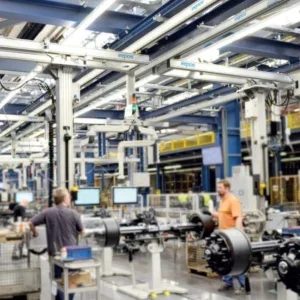Development of joystick technology has simplified operator control, taking into account safety issues and the ergonomic requirements of operator comfort and efficiency. Inductive technology has been instrumental in the advancement of joystick technology. In 1980 UK manufacturer PML FlightLink developed what it claims was the world’s first commercially successful, volume manufactured, contactless, inductive joystick. Inductive technology has since been used in all the company’s joysticks for operating cranes, access platforms and earthmoving equipment. All leading joystick manufacturers now also use similar technology.
Inductive technology uses non-contact sensing parts. This means that as an operator moves the joystick through 360° there is no wear on the sensing area from frictional forces or physically contacting parts. In joysticks without inductive technology, the mechanical contact mechanisms over time introduce wear to the sensing surfaces. Components are coated with lubricant to reduce friction but this attracts dust, which increases wear to the sensing surfaces, thereby reducing reliability and general performance. This wear, combined with machinery vibration, can result in complete failure of the wiping contacts and machinery breakdown.
Tough enough
Inductive technology is key to high performance, reliable operation and long service life. However, if the overall structure and mechanical components are weak, when it comes to tough crane applications, the joystick will simply not perform. PML says it focuses on these issues by designing heavy duty products using carefully selected materials which resist strain and fracture. Components must also be able to resist corrosion and the general ingress of contamination, whatever the potential environmental conditions. The outer envelope must be resistant to wear and tear from daily operator use as well as meeting the many CE and safety regulations.
Crane builders don’t make their own joysticks so they rely on outside suppliers to concentrate on tough construction to meet their demands for reliability and durability. In addition, product designers need to think globally so that a single solution can be developed to suit as many different markets and crane models as possible. Commonality of parts in product portfolios is an important consideration in producing competitive solutions.
Safety considerations
The joystick is the operator interface for cranes which are capable of lifting and manoeuvring large and heavy loads over considerable distances, so there is no room for error. One safety feature, known as ‘operator present’, is to ensure that the joystick only works when the operator is in position at the controls. As soon as the operator’s finger is removed from the button, the crane stops in a defined and controlled manner.
Estimating distance during manoeuvres can often be difficult for the operator, especially with a long, or fully extended crane boom. PML often installs a ‘thumb thumper’ feature to overcome this problem. The ‘thumb thumper’ sends a pulse to the operator through the joystick every time the crane moves a specified distance. An onboard computer calculates angles and distance and processes this information for the operator. This allows greater control during manoeuvres.
Since 1987, PML has also offered dual-decode units as a safety measure. These allow crane users to continuously monitor the correct operation of joysticks or systems monitoring the joystick. Failure in the joystick to meet defined parameters triggers a controlled shut down process to return the operated function to a fail-safe position. The failure mode is indicated through simple wiring, PML says, and can be used as clear fault diagnosis with the system controller.
Design of the whole joystick unit, including an optional built-in valve driver, varies according to the type of equipment it is operating. In an open cab vehicle, it is not suitable to have the valve driver built into the joystick due to climatic conditions. Placing the valve driver in a known environment away from the exposed cab situation provides increased protection as well as increased reliability and easier installation. Mounting the valve driver inside the joystick in an open cab can be done but experience shows crane customers feel more comfortable if the risk element is split. Secondary benefits include lower replacement costs if damage is inflicted from within the cab area.
Design
Joystick manufacturers have to design products for crane manufacturers who sell all over the world in a wide range of market segments. Ergonomic requirements vary with each customer and market sector. To crane manufacturers, ergonomic features are essential to provide the edge over competitors. Customers expect their cranes to be fitted with the latest ergonomically designed products.
In the last two years, PML has worked with major end users to combine customer produced handles, originally designed for hydraulic pilot controls, with PML’s heavy duty products. Customers are provided with mechanically and electronically proven technology that at the same time remains directly interchangeable with hydraulic and electronic solutions. Benefits can be considerable when working for crane manufacturers that want the technology but do not want to spend considerable time, money and effort on new internal cab design. Corporate image is very important and making changes is inappropriate for many customers.
User comfort
Operators have to sit for long periods of time controlling cranes, often in difficult conditions. Fairly basic design improvements, such as to unit height, its angle of use and making operation smoother can significantly aid operator accuracy and ease operational fatigue.
Extra functions can also be operated with the addition of switching style buttons placed around the joystick handle, depending on the ergonomic operation required. PML offers standard solutions using a variety of buttons depending on the specification or application, or works with customers to develop alternative solutions.
Finger trigger solutions have proved to be a major challenge due to sealing requirements to prevent ingress of water and other contaminants. Customer demands for ever more buttons built into the handle also provide conflict as the available space decreases. General trends have been hard to monitor, PML says, as market positioning stretches the developments in many directions, so it maintains a flexible approach to joystick design.
Adrian Higginbottom is product manager, joysticks at PML Flightlink






